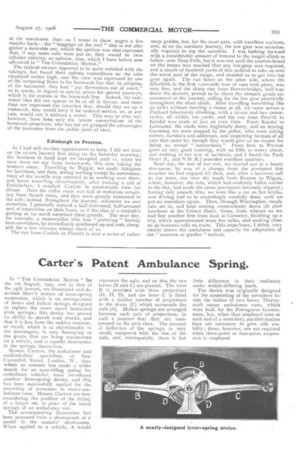Carter' s Patent Ambulance Spring.
Page 15

If you've noticed an error in this article please click here to report it so we can fix it.
In "Tun COMMERCIAL MOTOR for the ist August, 1907, and in that of the isth instant, we illustrated and described Marr's system of lever-spring suspension, which is an arrangement of levers and helical springs designed to replace the more usual laminated plate springs; this device has proved its ability to absorb road shocks, and that it is free from the sudden reaction, or recoil, which is so objectionable to the passengers, is very damaging to the goods that are being transported on a vehicle, and is equally destructive to the springs themselves.
Messrs. Carters, the ambulance and medical-chair specialists, of New Cavendish Street, London, W., than whom no concern has made a wider search for an easy-riding spring for ambulance vehicles, have introduced another lever-spring device, and this has been successfully applied for the mounting of stretchers in motor-ambulance vans. Messrs. Carters are now considering the problem of the fitting of a larger set, in place of the usual springs of an ambulance van.
The accompanying illustration has been prepared from a photograph of a model in the makers' showrooms. When applied to a vehicle, A _would.
represent the axle, and on this the two levers (13 and C) are pivoted. The lever B is provided with three projections (I), D, D), and the lever C is fitted with a similar number of projections in the drum (E) which surrounds the axle (A). Helical springs are arranged between each pair of projections, in such a manner that they are compressed as the axle rises. The amount of deflection of the springs is very small, compared with the rise of • the axle, and, consequently, there is but
little difference in their resiliency under widely-differing loads. The device was originally designed for the suspending of the stretchers inside the bodies of two heavy Thornycroft steam ambulance vans, which were built for the Portuguese Government, but, when thus employed (one at each end of a stretcher), parallel-motion bars are necessary to give side stability; these, however, are not required when three-point or four-point suspension is employed.




















